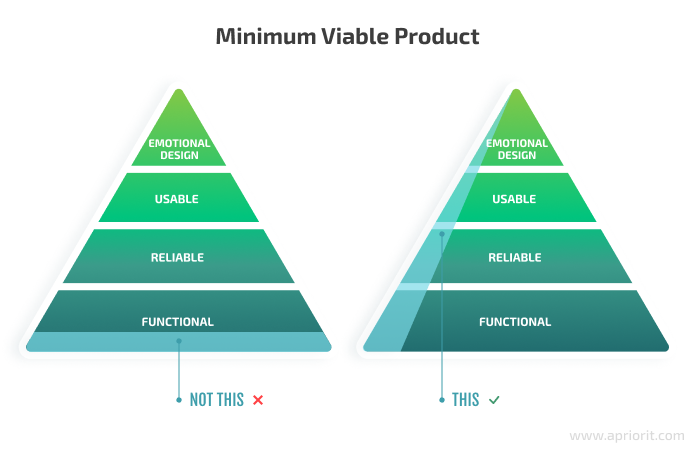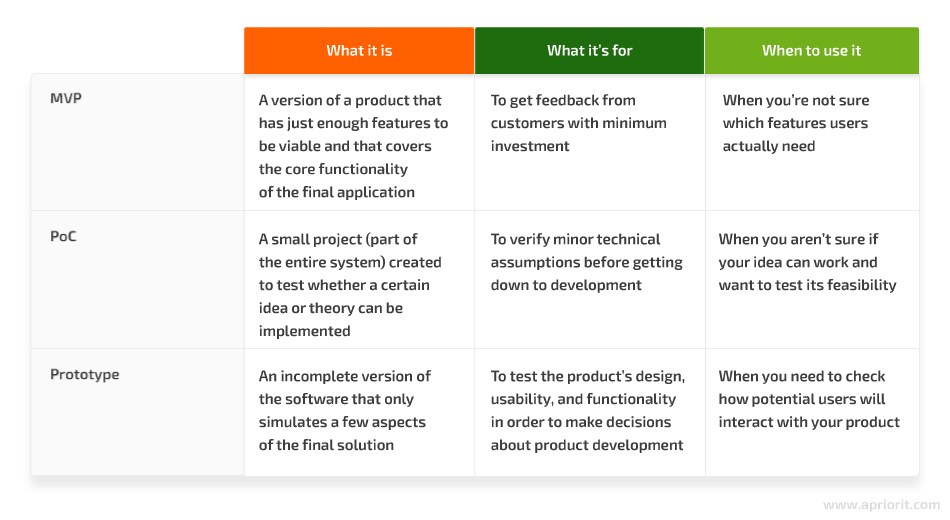Organizations develop a minimum viable product (MVP) version of their software to test the idea and get the first feedback from end users. Building an MVP involves developing a quick prototype, while development of all non-essential features is saved for later.
However, several software properties might not be essential for an MVP but will be vital for full-scale software. Paying attention to them may help you avoid costly rework at later stages of development.
In this article, we provide you with ways to future-proof your MVP’s scalability, flexibility, security, and maintainability.
This article will be useful for development teams who aim to not only deliver a quality MVP fast but also want to be able to use it as a solid foundation for their final product.
Why pay attention to non-MVP requirements during MVP development?
An MVP is a version of a new product that has sufficient features to satisfy early adopters or potential investors. Its main goals are to:
- Test the business idea
- Receive feedback from end users
- Incorporate users’ opinions into development
Since the MVP only needs to be usable and provide early adopters with a basic idea of what the product does, it includes the most necessary functionalities, properties, and design features of the final product.

MVP is sometimes used as a synonym for proof of concept (PoC) and product prototype. But while all three types of products are early versions of full-scale software that are created to validate ideas, their goals are somewhat different.
Here’s a brief overview of the differences between an MVP, PoC, and prototype:

Aiming to deliver the final product as fast as possible, developers sometimes sacrifice development best practices and ignore requirements that are beyond the scope of the MVP. The downside of such an approach is that your team might have to rework the entire product from scratch in order to turn your MVP into a viable full-scale solution.
Future-proofing your MVP helps to ensure that the product developed at this stage will be useful even after showing it to early adopters. Here are the key reasons to future-proof your MVP:

- Successfully turn your MVP into a full-scale product. When you take into account future product requirements while building the MVP, you move from a minimum viable product to a full-scale product. You’ll save time on reworking a large part of the MVP (or even reworking it completely) unless doing so becomes necessary after receiving feedback from end users and investors.
- Avoid changes to the architecture and frameworks. These elements are the foundation of both the MVP and the final software. The further down the development process you go, the more challenging and costly it is to make changes to this foundation. But what’s good enough for the MVP may be nowhere near enough for the final software. Considering future risks and possible changes to the product can help you choose an architecture and framework that will fit both the MVP and the full-scale solution.
- Ensure product quality from the start. While developing your MVP with future software requirements in mind may slow things down, it can help you ensure the quality of your product in the long run. You won’t need to worry about the product’s performance under a heavy load, ways to add new functionalities, software security, and the ability of your development team to grow and maintain a growing product.
With this in mind, let’s take a look at the four issues you may encounter once you decide to turn your MVP into a full-scale solution.
1. Implement scaling options for future high loads
An MVP usually doesn’t have a lot of users since it’s only created to test a business idea. The development team also may prioritize functional testing over load and performance testing and monitoring since they don’t anticipate any performance issues. But once you release the final product to a broad audience, you may face both performance and load issues.
In many cases, such issues are caused by a lack of computing resources. However, adding more resources doesn’t always help to improve system performance. If the final software inherits architectural bottlenecks, poorly optimized code, or a poorly designed database from the MVP, adding more resources to your system won’t help. And changing these elements in the post-MVP development stages may require a complete rework of your solution.
How to avoid overload and performance issues
Calculating the exact load on the final product at the MVP stage isn’t always possible. Expert development teams can approximately estimate the future load based on their experience working on similar software and the client’s product vision. And developers should take into account these estimates at the very beginning of MVP development.
When designing the architecture for your MVP, make sure it supports horizontal scaling so you can easily scale from an MVP to a full solution. Horizontal scaling allows you to scale your system endlessly, but you’ll need to add new infrastructure elements like a load balancer. This approach is more flexible and cost-effective than vertical scaling, which adds more computing power to existing instances. Vertical is an expensive way of scaling that is limited by the amount of hardware you can add to existing machines.
Although code optimization isn’t a priority at the MVP stage, it can help you ensure the quality of the final product and avoid unnecessary rework. Techniques such as code review and static code analysis can eliminate the risk of having code-related performance and load issues.

2. Use flexible frameworks for adding new features
After early adopters test the MVP and provide their feedback, the project’s scope and the original vision of the product may be changed significantly. You may end up needing to add functionalities that aren’t supported by the current software architecture. Also, the technical debt accumulated when working on the MVP can make implementing new features challenging.
The final product often differs from the MVP. For example, if the MVP application is relatively small, the MVP team may decide to use pure JavaScript on the UI, since there’s no need for any binding framework. When the team needs to add new features, they write typical code to map data with the UI using a copy-paste approach.
If feedback from end users makes stakeholders significantly change the scope, the development team faces a problem. When moving from an MVP to a full-scale product, the old approach will lead to high support costs and slow development since developers have to do everything by hand instead of using dedicated tools. Alternatively, the team has to rewrite the old code using UI frameworks such as React.js or Angular.
How to avoid inflexibility due to framework lock-in
Analyzing the initial product requirements can help you assess what type of features you may need to add in the future and which frameworks would best suit your project. However, feedback from end users may require you to implement functionalities that you didn’t plan on adding to your product.
Consider using common development frameworks from the beginning of work on the MVP, even if it may seem unnecessary. Such frameworks will allow you to simplify adding new functionalities in the future even if these functionalities don’t match the original product vision.

3. Ensure security from the start
Security is always critical, even during MVP development. Security issues during the MVP demonstration may create reputational problems, scare off investors, or even cause the termination of the project. So there’s no such thing as excessive security when working on an MVP.
A typical example here is the development of a multi-tenant SaaS application. At the MVP stage, there’s usually only one tenant and therefore no need to implement tenant isolation. The system’s multi-tenancy may not even be tested at this stage.
But if a new alpha client starts using the application before it’s released, they may encounter all sorts of security-related issues from data isolation to incorrect authorization.
How to secure the MVP
It’s best to start taking care of post-MVP security requirements when you’re still working on the MVP. Having a dedicated security manager on your team helps you be on top of security-related issues.
A security manager should oversee security audits during MVP development. These audits help you discover vulnerabilities in the MVP that you need to fix and determine possible areas for improvement.
Determine the core security mechanisms your final product must have and make sure to build your MVP with these mechanisms in mind. In this way, you ensure the protection of your product at all development stages and avoid the risk of experiencing a security breach at release or scaring off investors.

4. Keep detailed and consistent project documentation
Building an MVP usually requires a small team of several developers and QA specialists since this version of the product is limited. Small teams don’t always document their code clearly and with sufficient detail. Doing so takes time, which most MVP developers don’t have, and team members can simply ask each other when they need clarifications.
When moving from an MVP to the final product, the project usually gets a new, much bigger scope and needs a bigger development team, or even several teams. New team members need time to study the product before they can start contributing to it. If the technical documentation is poor, they will spend a lot of time investigating the existing code. They also need to study the product thoroughly to be able to maintain and support it.
How to make the MVP clear for newcomers
Keeping detailed technical documentation should be part of the usual development process from the start of the project. Documentation should include:
- A product description
- The product’s business goals and values
- Functional and non-functional requirements
- Architectural overview
- Feature list and feature specifications
- Development standards
Such documentation will help your team be on the same page, maintain the product, and be aware of all nuances in the code. Also, documentation helps new developers take technical debt into account and manage it efficiently instead of multiplying bad development practices and creating even more debt.
Conclusion
Building an MVP is an essential stage of software development that allows you to quickly test the business idea and get feedback from early adopters. However, it’s best to keep in mind core requirements for the final product (new features, scalability, security measures, etc.) even at this stage. Doing so allows you to save time and your project’s budget when shifting from MVP development to full-scale development.
At Apriorit, we always pay attention to software scalability, flexibility, security, and documentation when working on an MVP. Our experienced dedicated teams carefully assess the initial project requirements and possible future improvements to take into account when planning MVP development.
Reach out to us, and let’s start building your dream MVP!




